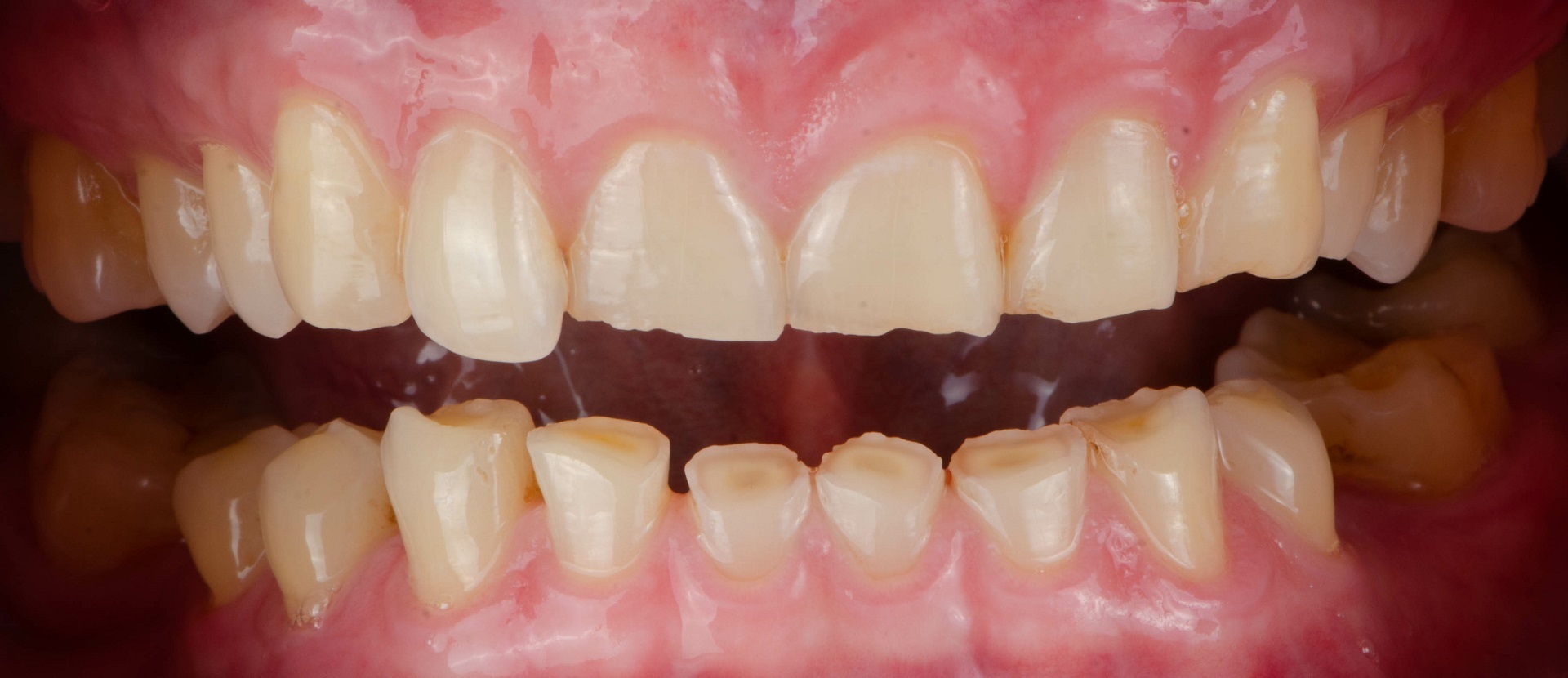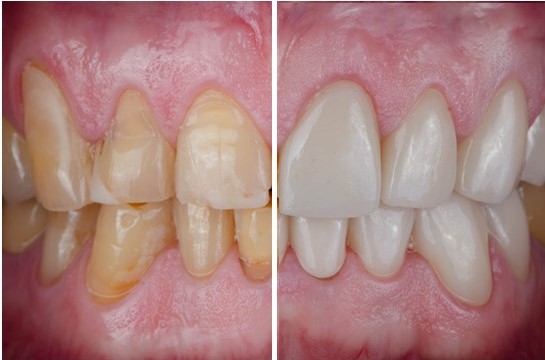
Bruxism leads to tooth wear
Bruxism is a disorder characterized by excessive, non-physiological clenching or grinding of the teeth. It involves excessive, involuntary muscle tension that leads to clenching and grinding of the teeth against each other.
The force exerted by the jaw muscles due to bruxism can be up to ten times greater than that during normal chewing. This condition can lead to the wearing down of tooth surfaces, temporomandibular joint damage, or even tooth fractures.
Symptoms of bruxism
In the initial stages of bruxism, symptoms of the condition are usually unnoticed. It’s only when severe pain occurs that an individual affected by this condition becomes aware of any abnormalities. Most symptoms can be categorized into three main groups.
Oral Symptoms
- Worn teeth
- Wedge-shaped defects (abfraction lesions)
- Enamel cracks
- Crumbling tooth edges
- Tooth fractures
- Tooth imprints on the tongue – known as ‘scalloped tongue’
- Visible white line on the mucous membrane of the cheeks


Treatment for bruxism
Bruxism is a challenging condition to treat and requires the patient’s commitment and practice of exercises. Since this disorder has a psychological basis, one method of treatment is pharmacotherapy and psychotherapy. However, this form of treatment is often difficult to carry out because long-term use of sedative medications has a negative impact on the body. Dental treatment for bruxism involves the use of specially designed occlusal splints, individually tailored to each patient. Splints, such as the Michigan splint, are usually worn on the upper or lower teeth, typically during sleep.
Tooth wear in Łódź
Tooth wear is the gradual loss of hard tooth tissues.

Tooth Wear - Symptoms
Unfortunately, the initial symptoms of tooth wear may go unnoticed by the patient. These include wearing down of cusps, increased tooth sensitivity to cold, hot, acidic, or sweet food and drinks. There may be a slight tension in the muscles attaching to the jaw.
A symptom of tooth wear can be discoloration and loss of tooth tissue near the gumline (cervical area), as well as a gray discoloration of the incisal edges of upper incisors. Defects around the necks of teeth can deepen over time, as can discoloration.
In more advanced cases, severe tooth wear occurs (even down to the level of the gums), often accompanied by crumbling of the incisal edge of the upper and lower incisors. In such cases, a minor injury or eating soft food can cause a piece of enamel to chip off. The symptoms can worsen, and there may also be headaches (especially upon waking), pain in the temporomandibular joint area (in front of the ears), and muscle tension in the neck. Sometimes the pain can be so intense that it resembles pulpitis in its intensity.
By far, the most dangerous consequence of tooth wear is inflammation or death of the dental pulp. Because enamel is hard and lacks cells, while dentin is softer and has cell extensions, it is more susceptible to faster tissue loss (and therefore quicker wear), allowing bacteria to penetrate the pulp more easily. This can lead to rapid progression of wear to the level of the dental pulp and bacterial penetration into the pulp.

Prevention
Firstly, it’s necessary to change dietary habits – avoid excessive consumption of acidic foods and drinks. Secondly, improve oral hygiene; thirdly, brush teeth correctly, especially refraining from brushing for half an hour after consuming something acidic. It may be necessary to consult a dentist specializing in tooth wear.
The dentist may determine that a change in dietary habits, providing instructions for proper tooth brushing, and gentle polishing of a tooth is sufficient. Additionally, they may recommend using products with a high fluoride content to protect the teeth and reduce sensitivity. Sometimes it may be necessary to prescribe sedatives if tooth wear is stress-related, or to create a relaxation splint and perform tooth reconstruction.

Diagnosing in a dental practice
To diagnose bruxism and the extent of tooth wear, a dentist examines the teeth and also assesses the facial and head muscles, as well as the temporomandibular joint, and performs palpation tests on the joint and muscles (e.g., asks the patient to bite down/relax, checks sensitivity to touch and movement).
An essential part of the diagnosis is conducting an interview about factors such as medications taken, past dental treatments, dietary and hygiene habits, asking about the type of work and associated stress levels, as well as inquiring about nocturnal rest and potential teeth clenching or grinding (before the visit, it’s advisable to ask a bed partner if they have noticed teeth grinding during sleep).

Treatment of worn teeth
There are several treatment methods, starting from simple changes in habits and ending with complex and long-lasting (up to 2 years), unfortunately costly treatment. In the case of moderate tooth wear, several solutions are recommended. If tooth wear is stress-related, it is recommended to refer the patient for rehabilitation. Rehabilitation treatments should focus on muscle relaxation. Another stage of treatment may involve the creation of a splint to protect the teeth from wear.
In addition to rehabilitation, tooth reconstruction is often necessary. The first and most cost-effective method is tooth reconstruction using composite material (so-called light-cured “filling”). For anterior teeth, composite veneers are used. For the reconstruction of posterior teeth, two methods are applied: fillings made by the dentist during the visit (but this is not always possible) or indirect restorations made by a dental technician. The latter method yields better results due to the curing process enhancing the quality of the filling and the precision resulting from full control over the process. However, the downside of using composite restorations is the lower aesthetic quality.
Another treatment method for tooth wear is the application of porcelain veneers on anterior teeth. They offer excellent aesthetics and when properly made, do not compromise tooth strength. The dentist will determine during the examination whether they can be applied in a given case. Contraindications to their use include severe tooth damage and untreated teeth grinding habit. In cases of severely worn teeth, it is possible to create dental crowns covering the entire tooth. It’s important to note that before placing crowns, root canal treatment and strengthening the tooth structure with a post may be necessary.
In the treatment of tooth wear, it’s crucial to remember that reconstruction of only the front teeth is not sufficient. The most important aspect is the reconstruction of the posterior teeth to protect the front teeth during chewing. Despite undergoing treatment, it’s important to understand that achieving complete recovery is very challenging. In extreme cases of tooth wear, the treatment can last a lifetime.

What to do after completing the treatment?
It is important to remember the doctor’s and rehabilitator’s recommendations. Depending on the needs, they may suggest changes in diet, tooth brushing techniques, or a daily set of exercises. Self-monitoring and avoiding situations that trigger clenching or grinding of teeth are also crucial.
After the restoration of the teeth, a protective splint is usually made to cover the restored teeth and prevent their damage in the future.
Relaxation splint Łódź
A relaxation splint or overlay, as the name suggests, brings relaxation and relief to the user from tension and pain in the muscles surrounding the temporomandibular joint.
People who deal with stress and habitual teeth clenching or grinding in their daily lives typically opt for the creation of a relaxation occlusal splint. What exactly is a relaxation splint, and what are its available types?


Michigan splint
This is an individually crafted relaxation splint for the upper teeth of the patient, made in a prosthetic laboratory. It facilitates the free movement of the lower jaw teeth over the overlay, thereby preventing teeth clenching. The increased distance between the maxillary and mandibular teeth stretches the jaw muscles and relaxes them.
MAGO Splint
The MAGO splint is an acrylic relaxation splint placed on the lower teeth. The mechanism of action of the splint is based on changing the existing neuro-muscular reflexes and restoring the normal function of the masticatory muscles. This leads to muscle relaxation, resulting in the alleviation of pain.
Patients use the above occlusal splints at night and for several hours during the day, from 6 weeks to half a year, and sometimes longer if the clinical case requires it. The duration of the therapy depends on the local condition and the symptoms the patient is experiencing. After a certain period, there is remission and the symptoms subside. There is stabilization of the muscular system, and at this point, prosthetic or orthodontic treatment can be initiated.



